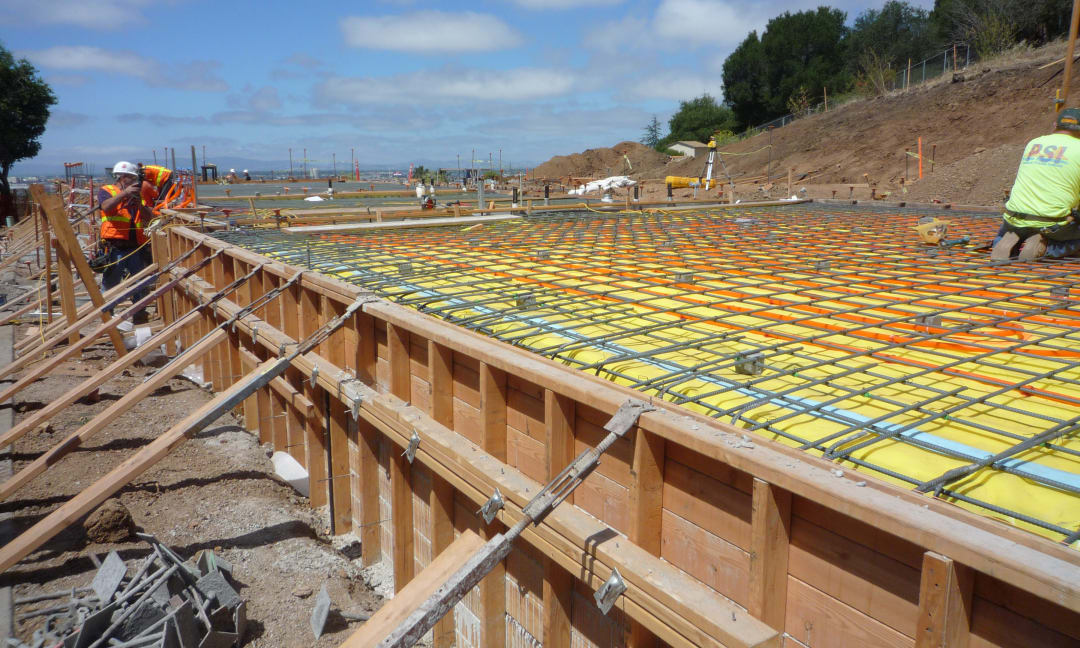By taking these steps upfront, architects can make a big impact during the building stage of a project
By Larry Strain, FAIA, March 29, 2017 |
| The early stages of construction for a net zero, low-carbon, LEED Platinum school project, designed by Siegel & Strain Architects. |
The need for sustainability in the design, construction, and operation of buildings is a reality. According to the Energy Information Administration, about 40 percent of the energy consumed in the United States in 2015 went directly or indirectly to operating buildings.
When you add embodied carbon—the energy and emissions from materials and construction—that number is almost 50 percent. As architects, we have the ability and responsibility to provide solutions that minimize the climate impact of the structures we design. And while practices to reduce operating impacts are widespread, less well understood are the carbon impacts during the building stage of a project.
My own “a-ha” moment on this front was when my firm calculated all the embodied carbon emitted from building the Portola Valley Town Center. It’s a very efficient project and has performed better than expected, but when we ran all the numbers we found that construction still emitted 1,000 tons of carbon—roughly the same as 10 years of operating emissions.
The good news is there are several steps architects can take to make significant upfront impacts in the design and construction process.
Reuse buildings instead of constructing new ones. Renovation and reuse projects typically save between 50 and 75 percent of the embodied carbon emissions compared to constructing a new building. This is especially true if the foundations and structure are preserved, since most embodied carbon resides there. With many projects, the first question should be, "Is there an existing building we can use instead?" This is an admittedly hard sell for architects—after all, many of us got into the business for the excitement and challenge of designing something new from the ground up. But channeling that energy and creativity toward making poor-performing buildings into something beautiful, sustainable and energy efficient has its own rewards, and yields substantial positive benefits.
Specify low-carbon concrete mixes. Even though emissions per ton are not relatively high, its weight and prevalence usually make concrete the biggest source of embodied carbon in virtually any project. The solution? Work with your structural engineers to design lower carbon concrete mixes by using fly ash, slag, calcined clays, or even lower-strength concrete where feasible. Though access to these materials varies across the country, with an increasing number of options there is almost always something that can reduce the carbon footprint of your concrete mix.
Limit carbon-intensive materials. For products with high carbon footprints like aluminum, plastics, and foam insulation, thoughtful use is essential. For instance, while aluminum may complement the aesthetics of your project, it is still important to use it judiciously because of its significant carbon footprint.
Choose lower carbon alternatives. Think about the possibilities. If you can utilize a wood structure instead of steel and concrete, or wood siding instead of vinyl, you can reduce the embodied carbon in a project. In most cases, it’s probably not possible to avoid carbon intensive products altogether—metals, plastics, aluminum—but you can review Environmental Product Declarations and look for lower carbon alternatives.
Choose carbon sequestering materials. Using agricultural products that sequester carbon can make a big impact on the embodied carbon in a project. Wood may first come to mind, but you can also consider options like straw or hemp insulation, which—unlike wood—are annually renewable.
Reuse materials. Whenever possible, look to salvage materials like brick, metals, broken concrete, or wood. Salvaged materials typically have a much lower embodied carbon footprint than newly manufactured materials, since the carbon to manufacture them has already been spent. With reclaimed wood in particular, you not only save the energy that would have been spent in cutting the tree down, transporting it to the mill, and processing it, but the tree you never cut down is still doing the work of sequestering carbon.
Use high-recycled content materials. This is especially important with metals. Virgin steel, for example, can have an embodied carbon footprint that is five times greater than high-recycled content steel.
Maximize structural efficiency. Because most of the embodied carbon is in the structure, look for ways to achieve maximum structural efficiency. Using optimum value engineering wood framing methods, efficient structural sections, and slabs are all effective methods to maximize efficiency and minimize material use.
Use fewer finish materials. One way to do this is to use structural materials as finish. Using polished concrete slabs as finished flooring saves the embodied carbon from carpet or vinyl flooring. Unfinished ceilings are another potential source of embodied carbon savings.
Minimize waste. Particularly in wood-framed residential projects, designing in modules can minimize waste. Think in common sizes for common materials like 4x8 plywood, 12-foot gypsum boards, 2-foot increments for wood framing, and pre-cut structural members.
Larry Strain, FAIA, is a principal at Siegel & Strain Architects.
This comment has been removed by a blog administrator.
ReplyDelete